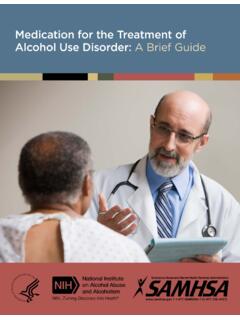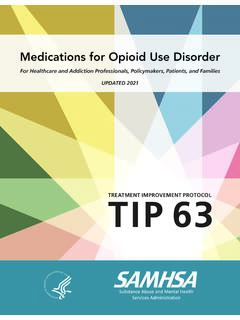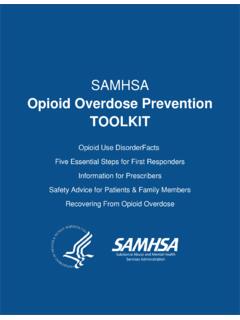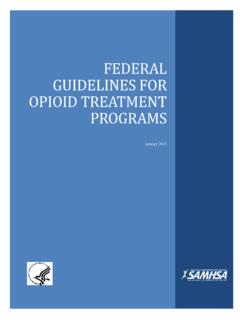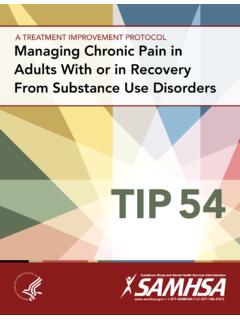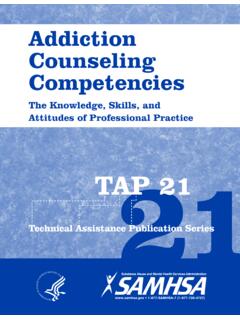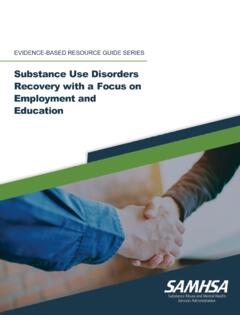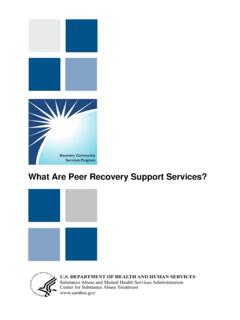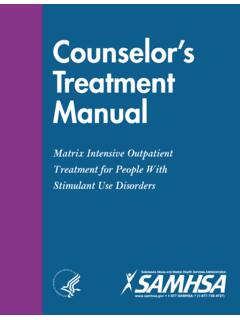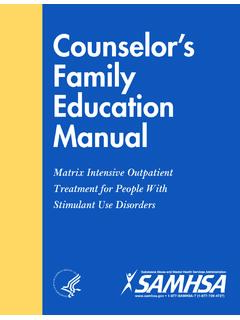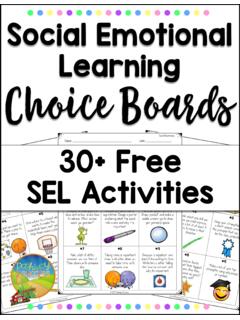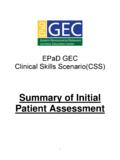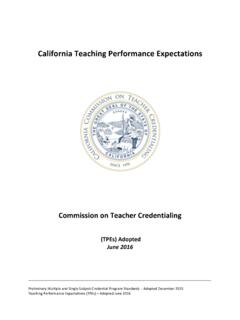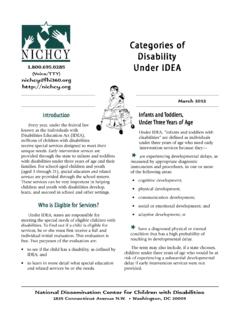Transcription of CREATING A HEALTHIER LIFE - Substance Abuse and Mental ...
1 CREATING AHEALTHIER LIFEA STEP-BY-STEP GUIDE TO WELLNESSCREATING A HEALTHIER LIFE: A STEP-BY-STEP GUIDE TO WELLNESS The Substance Abuse and Mental Health Services Administration s (SAMHSA) Wellness Initiative envisions a future in which people with Mental or Substance use problems pursue health, happiness, recovery, and a full and satisfying life in the community. Each individual s path will be a bit different. Every aspect of wellness can affect a person s toward all of them in one way or another is a great goal, because wellness relates directly to the quality of a person s life. This guide offers a broad approach for things we can do at our own pace, in our own time, and within our own abilities that can help us feel better and live longer. 3 CREATING A HEALTHIER LIFE: A STEP-BY-STEP GUIDE TO WELLNESSWHAT IS WELLNESS?Wellness is a broad concept. In this guide, we attempt to provide a broad, yet specific sense of what it means. We invite you to think of wellness as meaning being healthy in many dimensions of our lives.
2 That includes the emotional , physical, occupational, intellectual, financial, social, environmental, and spiritual parts. These dimensions are interconnected, one dimension building on also recognize that we live in a multicultural world, and wellness encompasses areas that may not be specified in this brief discussion. We believe, for example, that trauma is a universal human experience, and that our culture and spiritual beliefs impact our perceptions and everything we do. In summary, wellness is about how we live our lives and the joy and fulfillment and health we experience. When we worry about money (for example, debt or being able to afford what we need), we sometimes experience anxiety ( emotional ). This can lead to medical problems (physical), and trouble at work (occupational). When this happens, we may even question our own sense of meaning and purpose (spiritual). At the same time, when we are not working (occupational), we may lose opportunities to interact with others (social), and may not be able to afford the good food and medical care we need to stay well (physical).
3 We may even need to move our home to a place that feels less safe and secure (environmental). EIGHT DIMENSIONS OF WELLNESS**Source: Adapted from Swarbrick, M. (2006). A Wellness Approach. Psychiatric Rehabilitation Journal, 29(4), 311 A HEALTHIER LIFE: A STEP-BY-STEP GUIDE TO WELLNESSCREATING BALANCEC reating balance in our lives is an important part of wellness. Overall, a balanced life can mean many things, depending on culture, circumstances, resources, and other factors. Balance means making sure we have time to do the things that make us feel happy and fulfilled. This includes working (paid or unpaid), having fun, spending time with family and friends, participating in the community, being physically active including sexually praying, and relaxing and we each have individual needs, preferences, and capabilities, what we consider balance will also look different. And it s important for us to re-balance from time to time, to adjust to what is going on in our lives. When we re trying to get through a tough time whether it is stress, an illness, trauma, or an emotional challenge balance is especially important.
4 In these times, our habits and routines can help us get that feeling of control back. This means focusing on ourselves as well as the roles we play in the lives of others like being students, friends, parents, spouses, coworkers, congregants, hobbyists, community members, and citizens. Our roles and relationships help define who we are, what gives us a sense of purpose, and how our lives are interdependent on other people, animals, and the environment. Being engaged in life and relationships provides a measure of balance and overall wellness. For example, swimming has physical benefits (building strength, improving circulation), as well as social (meeting other people) and emotional benefits (relieving stress). But we don t have to swim laps every week to be well; getting into the pool even occasionally is a great step. Having a safe and clean living environment helps us feel organized and in control. It can be a way to get physical activity in as well, and offers the chance for partners and families to work together.
5 On the flip side, simply finding time to relax can go a long way toward finding balance in our lives. Down time can provide the space we need to think through a situation or work through our feelings, or just let us A HEALTHIER LIFE: A STEP-BY-STEP GUIDE TO WELLNESSEMBRACING SUPPORT FROM OTHERSMost of us know something that we do that makes us feel good about ourselves, or in balance. It could be as different as taking our dog for a walk, or balancing our checkbook. And any step in that direction, such as finding a new walking route or gathering receipts from a purse, is positive. However, sometimes we may want advice from family and friends. That s OK, too, and is where support from others comes in. Talking with someone who has been through similar things whether it is a Mental health issue, addiction, trauma, pain issues, smoking, diabetes, bullying, or Abuse makes us feel less alone. When we realize others have had similar feelings and experiences and have been able to move forward and grow, it can give us the confidence to move forward, too.
6 With a support group, we can expect: Supportive input from people with a range of backgrounds who have experiences similar to ours; A chance to support others by our presence, compassion, our ideas, and empathy; and People who can suggest services or resources we might not have considered. We can find supportive people in many places a community or church/synagogue/mosque/temple group, at work, or through volunteering efforts, to name a few. VALUING ROUTINES AND HABITSH aving self-defined routines and habits can offer personal balance and satisfaction. Routine and habit is generally determined by our basic needs (nutrition/food, shelter, social affiliation, safety, etc.), and the various roles we occupy in society. Our habits affect what we eat, what we wear, how we relate to others, how we go to work, how we spend or save money, and more. Habits become ingrained in us and are often tough to change. For example, we might put ourselves down or feel we need a particular thing or person to get us through a tough spot.
7 We can learn otherwise. Life demands, stress, crisis, or trauma can impact or alter our routines and habits. This can lead to emotional (anxiety, depression), social (cranky, isolated, angry), or physical (tired, agitated) imbalances. Establishing new, better habits that support our wellness goals and values can be challenging, but worth it. Developing HEALTHIER routines and habits in our lives can lead to positive feelings ( emotional ), relationship satisfaction (social), increased energy (physical), inspiration ( emotional ), and a feeling that we are using our creative talents, skills, and abilities to engage in activities (occupational, intellectual, spiritual). 6 CREATING A HEALTHIER LIFE: A STEP-BY-STEP GUIDE TO WELLNESSWe may already have regular practices that make us feel better, such as mindfulness exercises, meditation or yoga, or calls to friends. It could even be avoiding the news at night, or spending less time online. You, as the expert on yourself, will know what works and what doesn t in all the dimensions.
8 When you are not sure, you can ask someone and think together about what makes sense and what next steps might work best. We can also consider: Being active in activities that have purpose. If our daily routine lacks meaning, we can feel distressed or powerless. Increasing activities that contribute to our wellness. Talking with a friend at the start of the day may help set a good intention or plan for the day. Getting a good night s rest. Insomnia can noticeably impact social relationships, physical and emotional reactions, productivity, and our ability to concentrate and accomplish tasks. Being aware of the right amount of social interaction. It s important to know our limits. Remembering that time zone changes or daylight saving time can impact our mood and our routines; readjusting is normal. Using a routine that works for us. Calendars help us remember when or how often we want to get things done, such as get an oil change, clean the refrigerator, celebrate an accomplishment, call a friend or family member, check our financial records, and schedule an annual physical.
9 Repeating a behavior until it becomes automatic, such as taking medication. Checklists help us make sure that important tasks are not being forgotten. CREATING a wellness lifestyle can be challenging, but finding the right information, supports, and resources and tracking our progress can help us get A HEALTHIER LIFE: A STEP-BY-STEP GUIDE TO WELLNESSIMPROVING OUR PHYSICAL WELLNESSA healthy body. Good physical health habits. Nutrition, exercise, and appropriate health care. These make up the physical dimension of wellness. A few ways we can get there might be choosing things that make our body feel good and trimming back the things that bring us down. We can also feel better by CREATING a routine that balances activity with inactivity, and that is manageable within our obligations and needs. Our body is intelligent, and learning to listen to it more deeply may be very important and Do you have access to fresh, healthy food? Are you in a position to eat at home so you can better track what you are putting into your body?
10 Are you improving your diet by setting small goals for small changes each day, week, or month? Check out local food co-ops if one is in your area for good, affordable food. Visit USDA s Choose My Plate ( ) or Food ( ). Meet with dietitians and nutritionists if you need help, or try programs like Weight Watchers. Explore self-help support groups and organizations, like TOPS or Overeaters Anonymous. Physical Activity Are you getting regular physical activity whenever you can, and making it fun? Have you been taking shortcuts to exercise, like parking further away from the store and taking the stairs instead of the elevator or escalator? Have you identified your healthy Body Mass Index and begun working toward it, one day at a time? Join and visit local gyms, YMCAs, and fitness clubs, or join a neighborhood pool. Look through fitness and other magazines for exercises you can do at home. Check out free resources, such as YouTube, to learn how to do yoga or other exercises.
